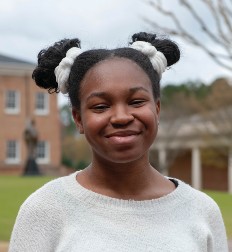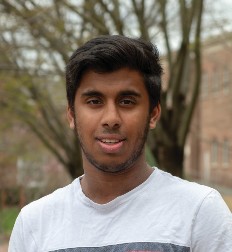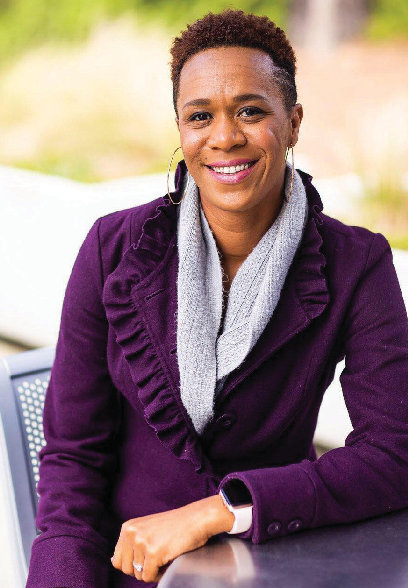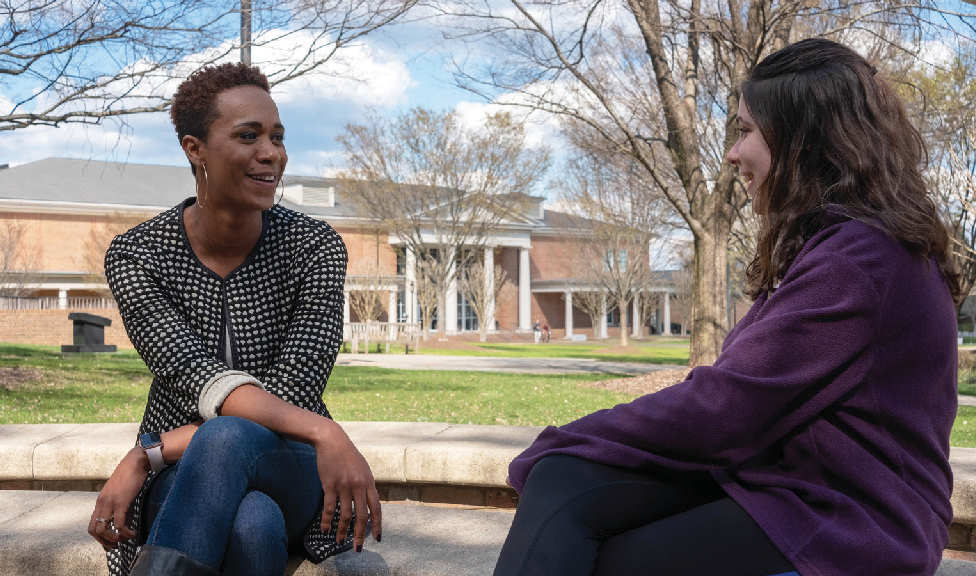Equity, inclusivity, and diversity have been core commitments at CA since the school’s founding. These commitments are resonant not only the school’s diversity mission statement and statement of community values, but are refected through the work of our strategic plan, our approach to programming, and, of course, by our diverse community itself.
This July, the CA community will welcome its frst Director of Equity and Community Engagement. Housed within the Center for Community Engagement, the role encompasses and expands the responsibilities of the former Director of Diversity and Inclusion.
The shift in title from diversity” to equity and community engagement is purposeful. It refects the shifting landscape of equity and inclusivity work and a more nuanced recognition that diversity alone is not enough; a diverse community is not necessarily an equitable one. The change signals CAs ongoing commitment to creating a truly equitable, inclusive, and diverse community where everyone has an opportunity to have a voice, be heard, and thrive.
As we look to the future and the work ahead, some faculty and students had the opportunity to sit down and refect on some of the key moments and ways that CAs commitment to equity, diversity, and inclusivity has been manifested for them this year.
Student Perspectives
Cary Academy counts diversity and inclusion as one of the key tenets in building its programs, but how does that shape the experience of students, in and out of the classroom?
“It’s interesting to learn new things about other people’s experiences and passions… it creates, not only a deeper appreciation of your own cultural group, but an understanding where others come from… it helps you understand how you can connect.”
OM NAPHADE
For many students, participation in affinity groups — organizations that bring students together around a shared identity, be it race, gender, sexual orientation, religion, or ethnicity — is one of the ways that equity and inclusivity work manifests on campus.
For Kaela Curtis (‘20), Om Naphade (‘20), and Clay Thornton (‘21), participation in CA’s affinity groups has been transformative, shaping their sense of self and community, providing
crucial support networks that help them navigate their world, and even shifting their ambitions and long-term plans.
“Affinity groups are an opportunity to connect and socialize with other students who look like you and get it,” explains Curtis, who serves as secretary
for the African American Affinity Group. “When I transitioned to CA, there was a major culture shock. Having peers who understood my experience and identity was extremely helpful.”
“At school, I had never been able to really talk about this part of who I am, until last year when I was able to join the Gender and Sexuality Alliance,” notes Clay Thornton, vice-president of the GSA. “I’m thankful that we have such an open and diverse LGBTQ community on campus. Some schools don’t have a GSA, or aren’t allowed to have a GSA, whereas we have 30 or more students who show up at every meeting.”
The size and diverse makeup of CA’s student body allows our affinity groups to be as varied and inclusive as the communities and identities that they encompass. Thornton expressed relief to find such diversity within the LGBTQ community at CA, noting that “a shared identity doesn’t mean we’ve all had the same experience or interests.”
Naphade, the event coordinator for the Indian Subcontinent Affinity
Group (ISAG), echoes that sentiment. He underscores that affinity groups are anything but monolithic; the cultural diversity within ISAG has led to a better
understanding of himself: “It’s interesting to learn new things about other people’s experiences and passions… it creates, not only a deeper appreciation of your own cultural group, but an understanding where others come from… it helps you understand how you can connect.”
In CA’s affinity groups, allies — students who do not share the same core identity as the affinity group, but respect, celebrate, and support their identity
and equality of rights — are welcome. Allies often bring different perspectives, insights, and backgrounds and can play a critical role in deepening dialog, building further connection for member students.
Curtis notes that inclusion of allies can spark discourse — around topics like conflict and microaggressions—that might not otherwise occur. “Sometimes, people will say something about you
to an ally [who looks like them] that they wouldn’t say to your face. That’s led to some tough conversations and
realizations that wouldn’t otherwise have happened,” she offers.
Recounting his experience at the Student Diversity Leadership Conference (SDLC), Naphade recalls being surprised to learn that some students of color at other schools had encountered obstacles in building affinity groups at their own schools: “I met students at other schools where they might be the only member of their identity group at their school. That made me realize how thankful I am for CA’s diverse community and for our allies. I ended-up mentoring students from other schools about my experience at CA.”
“UNDERSTANDING HOW LAWS AND INSTITUTIONS AFFECT OUR DAILY LIVES — IT’S HARD TO TURN IT OFF. ONCE YOU KNOW, YOU FEEL COMPELLED TO DO SOMETHING ABOUT IT.”
— KAELA CURTIS
Curtis, Naphade, and Thornton all lamented that sometimes equity and diversity work is perceived as “something you do, like a club.” “People don’t always understand that it’s bigger than that, that it is about being better people, making all of our lives better. That’s why we’re thankful for COEXIST; it does a lot of that work,” offers Thornton.
COEXIST, an intersectional student organization that advocates for diversity, inclusivity, and equity for the entire Upper School student body, is comprised of the leadership of all of Cary Academy’s affinity groups. Curtis explains that COEXIST serves as “bridge across different identities.”
It is a link that Thornton credits with strengthening campus-wide equity efforts, ensuring that students who don’t identify with an affinity group still have a voice in the conversation about diversity at CA. “If we are all only active in our own affinity groups, not knowing what else is happening on campus, or other groups’ perspectives, we might not be able to have a uniform push for issues of diversity and equity,” he explains.



COEXIST has supported the student body in times of crisis, working with affinity groups to foster campus-wide conversations about contemporary needs and concerns. Most recently, COEXIST is partnering with the Muslim and Jewish Students Associations to give students the opportunity to process the mosque shootings in Christchurch, New Zealand. “It was really wonderful to see so many students from across campus at the talk,” beamed Curtis. “It felt great to be able to talk about white supremacy and have people understand how I felt.”
For Curtis and Thornton, the experience of being part of an affinity group has altered their course. “In Middle School, I was very much interested in STEM subjects, but being involved in all of this diversity work has me thinking much more about [working in] government and politics. I’ve been enjoying my history and English classes more,” says Thornton.
Curtis agrees, “I definitely want to be involved in issues of political science and public policy as a result of these experiences. Understanding how laws and institutions affect our daily lives — it’s hard to turn it off. Once you know, you feel compelled to do something about it.”
Last November, Upper School Dean of Students Donna Eason and Experiential Learning Director Michael McElreath were part of a CA team that attended the National Association of Independent School’s People of Color Conference (POCC) in Nashville, Tennessee; the group also took five students with them to the simultaneous Student Diversity Leadership Conference. Recently, they had an opportunity to sit down and reflect on their experience and why the POCC has become such an important professional development opportunity for CA faculty.
EASON: What I liked best about the conference was being in such a welcoming environment. While I was in the physical space, I could feel my body and emotional state relaxing. I didn’t feel like I had to be reserved or guarded; I didn’t have to “put my mask on.” There was such a sense of freedom. What was your favorite thing about the conference?
MCELREATH: It was being with people who were friendly and outgoing and a little less “buttoned-up.” I felt very included and welcomed in that space as well, even though it was made clear that if you were there and not a person of color, you were welcome as an ally, but this conference was not “about you.” In most places, I feel included automatically; I am glad that you had a chance to feel that way also.
EASON: I felt like my culture was being presented in this space, which is not always something that I get a chance to experience. In fact, remember the first day when they had the Tennessee State University marching band? I enjoyed it immensely because that is such an important part of an HBCU experience. You could just look around and see that everyone was enjoying it, not just people who were already familiar with it. It was something that I don’t often get a chance to celebrate in this kind of setting, especially at an NAIS conference.
Another instance that was very important to me, and I don’t know if this would be difficult for you to understand: in some situations, when it’s a particular ethnic or minority group, sometimes when you are experiencing something that’s so specific to your culture in a setting where your “group” is not the majority of the people in attendance, there is this worry that you’re going to feel embarrassed or that others will not understand it and ridicule it. It’s a very uncomfortable feeling and a very unfortunate one, but it does happen sometimes. At this conference, however, there was just a sense of comfort and acceptance among everyone.
MCELREATH: That’s part of what privilege is — never having to second-guess yourself or be ashamed about aspects of your culture.
EASON: Another thing that I found very interesting and could apply here at CA was a great workshop about African- American, African, and African-Caribbean differences. It was so eye-opening. Oftentimes, there are not enough people to divide up like that; we are usually placed in the “black group.” At the POCC, we were able to dialogue with each other and truly show that there is no singular “black experience.” We are not a monolith — we have differing concerns and interests. I learned about situations and ideas that I hadn’t even considered that were high priorities for others from different countries. And although we were grouped by countries in this session, we understood that these were individuals speaking, not spokespersons for countries. This helped me because we have the African-American affinity group at CA that includes many students whose parents or the students themselves are immigrants, and we need to make sure we maintain an atmosphere that is attentive to and addresses the needs and interests of all.
MCELREATH: Speaking of affinity groups, it was interesting to be in a space where we had the affinity group gatherings and one of the affinity groups was “White European Heritage.” There were over 1,000 white people there; still, it was something just to be labelled in a way that said, “Here’s the salient thing about you. You’re a white person — go over there!” That was a turning of the tables.
EASON: I was just wondering about the experience for you — when you did have an affinity group — because a lot of times at conferences you’ll see groups based on race, but the groups in the majority are not labelled by race as “white.” Did that feel different to have an actual affinity group that had a race label?
Some of the conversations we need to have in our community and our world require some level of discomfort to get to honesty, to get to improvement. Being uncomfortable some of the time is a necessary part of the journey. But, I do think that CA tends to feel like a safe space for me as an adult, and hopefully for mostof the students as well, to do that hard work as we try to model respect, integrity, and compassion.
— MICHAEL MCELREATH
MCELREATH: Well, you know my background studying race, so, no, it didn’t weird me out. However, it was striking that in one of those sessions I was with three colleagues from schools in Alabama and Virginia. They gave a litany of reasons why they felt like they had no chance of taking back things they were learning at the conference to their schools. It made me sad for them. It gave me the impression that CA—although we have many things we still need to work on—has actually come quite a way towards making our community fully inclusive. I heard some professionals basically saying, “I feel silenced because my institution does not want to hear what I have to say.” I have never felt that here, but I’m sure there are some at CA who may feel that way.
EASON: That happened to me too, when talking to other people. One thing that came up several times was affinity groups. I was pretty surprised at how amazed they were with what we have. I’ve always thought affinity groups are a great idea, and I do love the way we have incorporated them into our community. But to hear how other schools were in awe of how we’re able to do it — they might say, “well we might be able to get away with this, but not be able to do that”— like you, it made me sad, but also a little proud of what we’re doing. And I know we’re forever growing, but the fact that there is the opportunity to have something like affinity groups or discussions or things like that — it made me really want to join forces with other schools, to mentor schools in some areas, and be mentored in turn.
MCELREATH: That’s a good point. I think there are definitely things that we may know and could share, and then there’s also a lot that we could learn as well. I’m glad that we are a part of the Triangle Diversity Alliance. We do the yearly conference with them, but we could do more, and maybe we should make it a more regular collaboration. I’m excited to have our new Director of Equity and Community Engagement help us figure out how to do that.
EASON: And I’m excited about us really incorporating more discussions. Sometimes we shy away from certain topics, and I think with us having opportunities like the POCC & SDLC, and with both faculty and students coming back and sharing what we learned, we will start to have conversations that are difficult. But, it feels like we’re in a safe space to attempt it.
MCELREATH: I agree that we have to create the space for those kinds of things to happen, and also for them to be productive. I think sometimes people confuse being safe with being comfortable. Some of the conversations we need to have in our community and our world require some level of discomfort to get to honesty, to get to improvement. Being uncomfortable some of the time is a necessary part of the journey. But, I do think that CA tends to feel like a safe space for me as an adult, and hopefully for most of the students as well, to do that hard work as we try to model respect, integrity, and compassion.
Community Conversation
WELCOME, DANIELLE JOHNSON-WEBB

Danielle Johnson-Webb joins the Cary Academy community from the Montessori School of Raleigh, where she served as the Director of Enrollment Management. There she worked to create equitable recruiting policy and procedures to increase diversity within the MSR community. In service of that goal, she leveraged her equity and inclusivity training including her participation in programs like Deconstructing White Privilege, (Un)Privileged: The Cost of Being Poor at an Elite Institution, and From Diversity to Plurality to develop and implement training, curriculum, and programs in the areas of equity, inclusion, and justice for all employees.
In addition to her experience with MSR, Danielle has a long history of working within independent schools including Duke School and Davidson Day School in various roles, ranging from faculty member to senior administrator. In addition to equity and inclusivity work, her varied experience includes teaching, enrollment management, development, and communications. Altogether, her experience affords her a unique and holistic understanding of independent schools that will undoubtedly inform and beneft her work at CA.
Outside of her independent school experience, Danielle returned to her alma mater, North Carolina Central University, as a commentator for the NCCU Sports Network and Time Warner Cable. In college, she was a member of the North Carolina Central University championship women’s volleyball program and the women’s basketball program. You’ll likely fnd her on the court and cheering from the sidelines next year as she gets to know our community.
In anticipation of her arrival, Chief Student Diversity Officer Lily Levin (’19) sat down with Johnson-Webb to discuss her perspective and vision for her new role.
WHAT IS YOUR MAIN PRIORITY WHEN WORKING WITH STUDENTS?
I want to know every student. I’d love to be able to walk down hallways and, even if we don’t have a daily exchange, know who you are. I want to get to know the school not just [in terms of] academics, but the social- emotional piece as well.
My first year I like to go to everything. I’m in the concerts, the sporting events, the clubs, the robotics competitions. That’s important to me, to be part of a community. It builds trust when students see that you’re not just there from 8am to 3pm, just for the job, but that you want to be part of their community.
One thing that’s also going to be important when working with students is grace. I think we’re in a time where students are so far ahead of adults that sometimes there’s not a lot of grace given to us. And, I think that that’s going to be one of my big topics… really working with students to say, ‘Give us a little grace, we’re learning, we’re not as advanced as you all, we’re not in it as deep as you all.
HOW WILL YOU ENGAGE INDIVIDUALLY WITH OUR VARIOUS AFFINITY GROUPS WHILE EMPHASIZING BOTH INTERSECTIONALITY AND FUSION?
Intersectionality is such an important thing. We often look at people one- dimensionally and we have to look at all aspects of an individual. Because each aspect can bring a different experience and we have to honor that.
I think it is important for you to have a group that you identify with and to have time with them, especially when you’re in a place where you may be the minority. But, I also want to have those bigger conversations of ‘let’s all come together, sit together, and talk and see how we can progress forward.’
WHAT UNIQUE AND PERSONAL ASPECTS OR EXPERIENCES DO YOU BRING TO THIS ROLE?
I started out in independent schools as a teacher. I was the only African- American teacher on staff; the other African-American adults on campus were janitorial staff. I remember thinking ‘Who do the black girls have to look to? Who’s in leadership?’
It’s always been my goal to be one of those people — someone that, not only African-American girls can look up to, but others as well — to say we have people of color in leadership in independent schools.
I’ve seen independent schools as a teacher and I’ve seen them as a mid-level and senior administrator. I’ve been in many different roles — my focus hasn’t just been diversity or equity or justice. I can see the school as whole. I think that perspective is a good one and it really helps when you’re doing equity work because it can be messy.
HOW WOULD YOU STRUCTURE THOSE IMPORTANT CONVERSATIONS ABOUT WHAT LEADERSHIP LOOKS LIKE AND YOUR ROLE WITHIN LEADERSHIP?
For me, when you have to have really hard, tough conversations, you have to build trust first.
You can’t just come in full force — I wouldn’t want anyone to do that to me. It’s about learning about the community. What is Cary Academy? How does it work?
I can’t just come in and say it should work this way — I need to observe . . . when you show interest in what others are doing and what they’ve done in the past, I think you build that trust. And then you can start having those conversations: What does leadership look like? Who should be involved? Are we doing enough? Are we represented enough?
Intersectionality is such an important thing. We often look at people one- dimensionally and we have to look at all aspects of an individual. Because each aspect can bring a different experience and we have to honor that.
WHAT DO YOU WANT TO ACCOMPLISH IN FIVE YEARS?
Looking five years out, I’m really excited about the community engagement piece. Cary Academy has done a ton of work in the community; it’s impressive. How can we continue that work? How can we expand it?
Also, the [student body] diversity numbers are higher here than most [independent schools], so focusing on making sure people feel good when they’re here. From the students I’ve talked to, they do. We need to continue that work.
WHAT MOTIVATED YOU TO APPLY FOR THIS POSITION?
Cary Academy is a school of choice. It is a school and community that people want to be a part of. I love that aspect. I’ve always admired the fact that Cary Academy is not afraid to be bold and I really want to be part of a community where you can have these conversations and do this kind of work. I mean, [during the interview process] when I sat down with a group of students, I was blown away… I’m still thinking about it. I can remember every conversation that I had around that table.
ANYTHING YOU’RE MOST EXCITED ABOUT?
I’m excited about joining a new community and meeting new people. I’m really excited about the equity piece, what that will mean for students, and for those partnerships. And, I think that being part of an independent school and being able to engage the community and having the resources to do so is really big.
I’m also excited for the seniors that I interviewed with to come back and see me because you were all so impressive. I’m happy to be a part of this school that has amazing alumni and that we can see how you all do as we move forward. That’s most gratifying to me — when students come back and they’re just amazing beings.

